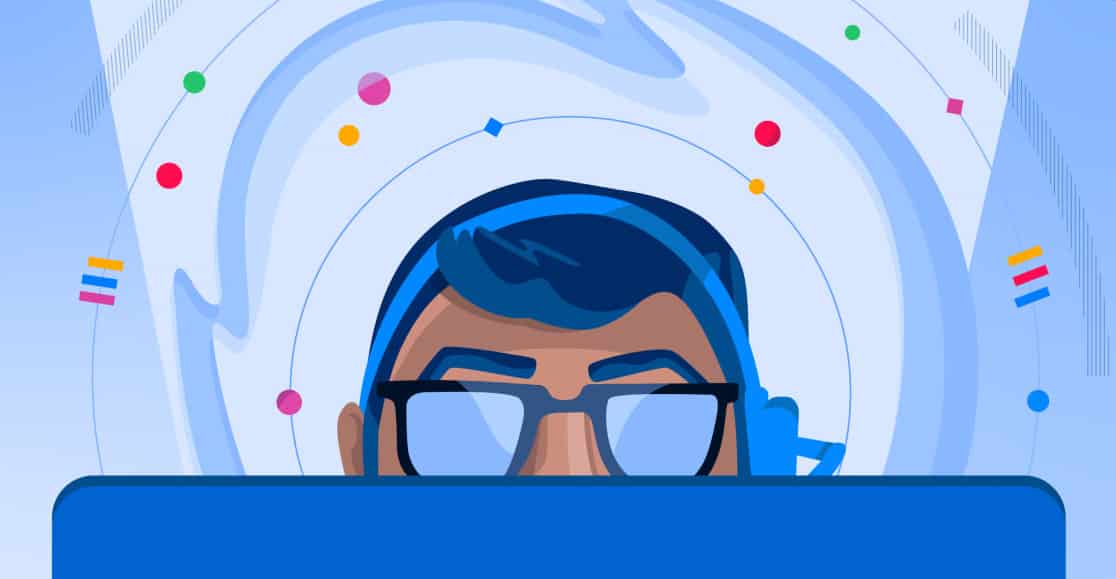What is helpdesk automation?
Using AI, helpdesk automation tools take customer queries and resolve emails, phone calls, tickets, and other support chats. As the AI resolves more and more of these queries, the helpdesk analyzes resolutions and becomes more intelligent, learning how to improve customer and employee experiences. Helpdesk automation reduces repetitive, manual work that support agents would typically handle.

Get Started with AI
Capacity’s customized AI Assessments can help:
- Identify opportunities for using AI
- Prioritize use cases that fit your goals
- Build an action plan for implementation
Will AI have an impact on helpdesks?
AI is already impacting helpdesks, especially for company support teams in HR, IT, or Customer Service roles. Helpdesks powered by AI and automation become smarter because they learn from humans. The best helpdesk automation tools can deflect around 90% or more Tier 0 and Tier 1 questions.
Plus, due to better technology, customers now expect more help, faster: 83% of consumers expect to solve complex problems in just one interaction or by speaking to just one contact.
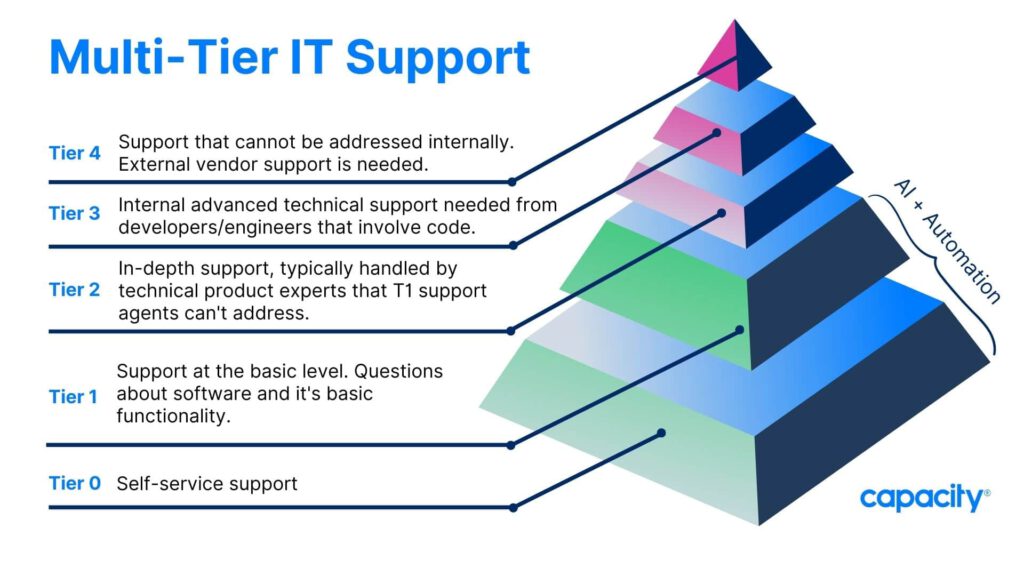
Top 5 impacts of service desk automation
Service desk automation is an evolution of helpdesk automation. Instead of closing out tickets, support teams are freed from the many helpdesk tickets that pile up daily. Sometimes, automated service desks can tackle even the Tier 2 support if the service desk automation is good. Here are 5 significant ways that automated service desks can positively impact businesses.
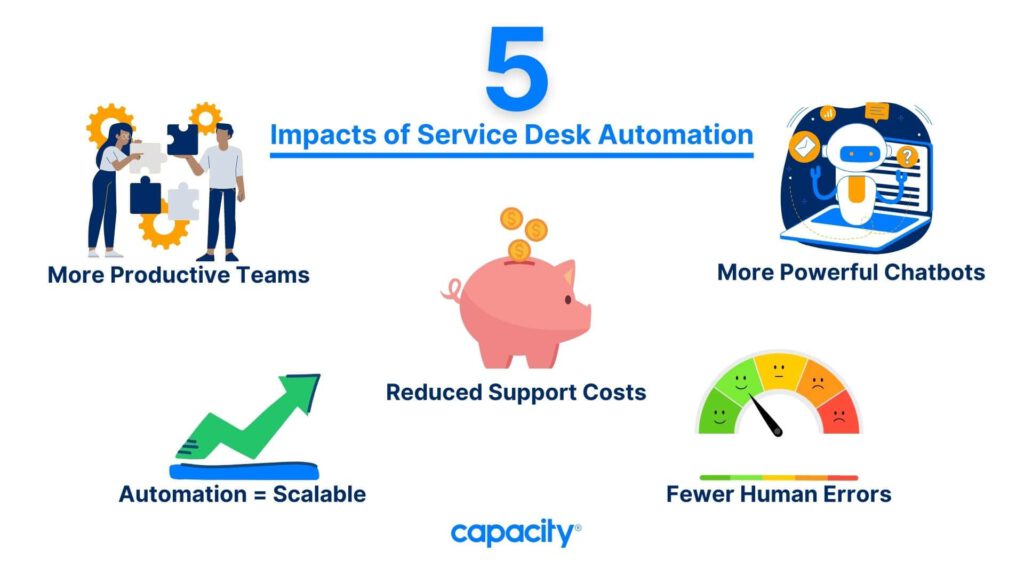
1. More Productive Teams
It’s 2022. People expect accurate responses. This places a lot of pressure on support teams. Companies dedicated to automating their service desks will remove blockers for employees, reduce burnout, and retain top talent. New advances in technology, like generative AI, make it possible to completely shift answering repetitive emails or tickets.
Service desks, once seen as unicorns, are now playing catchup with companies on the leading edge of automation and AI. Companies that choose to keep outdated helpdesks will continue to face ticket fatigue and repetitive questions, resulting in unproductive teams, ticket cherry-picking, and other common pain points.
2. Service Desk Automation = Scalable
Service desk automation is more important than ever for any business that wants to grow and scale. An automated service desk is no longer a “nice to have.”
As customers and employees field more questions via chat and email, automating responses that don’t require human intervention saves organizations tons of time and money. Instead of adding agent after agent, automated service desks can handle FAQs and route customers to the right place without ever having to wait for a live chat agent or an email response.
WIth 90% or more of tickets deflected, more technical questions can be escalated to humans to resolve.
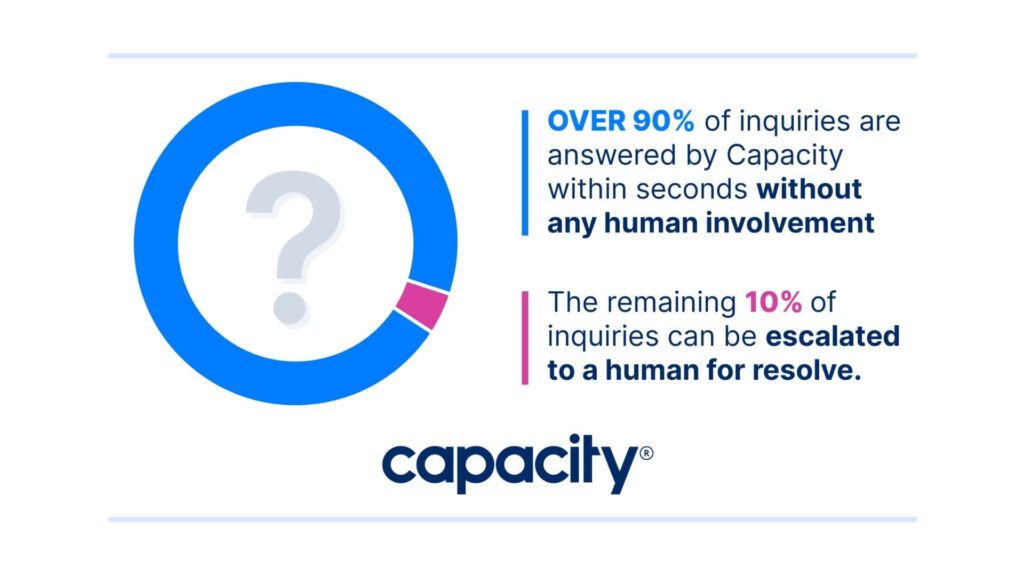
3. Reduced Support Costs
On the surface, service desk automation software looks like it comes with a hefty price tag. But, in a world where tickets and tasks are increasing exponentially, and support is expected immediately, companies can’t afford to simply add support agents to contend with quick questions that come in via chat, phone, and email.
When businesses choose an automated service desk, they are choosing to invest in their employees by automating low-value tasks for support teams and making room for them to handle the more challenging questions. Service desk automation increases client retention and is already saving support teams hundreds of hours while keeping teams lean and agile.
4. More Powerful Chatbots
Chatbots get a bad rep…for a good reason. It’s easy to confuse live chat or early AI bots with today’s Conversational AI. As part of service desk automation, conversational AI bots can be placed in apps or internally, whether using Slack, Microsoft Teams or wherever support teams communicate.
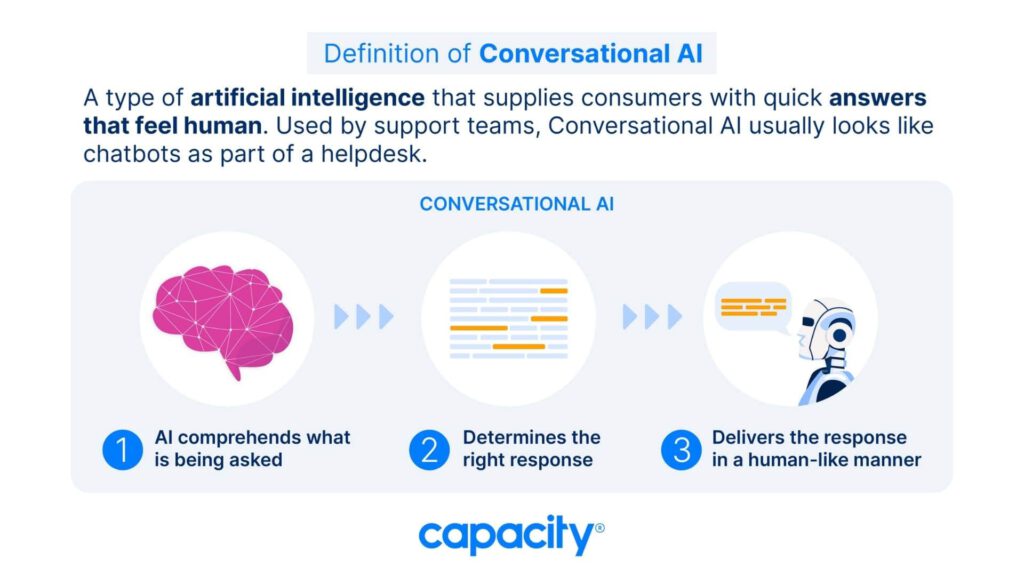
Whether onboarding a new customer or a team member, the best automated service desk chatbots can match a user to the information, they’re seeking in seconds. Capacity’s team uses Conversational AI in Slack to locate and share docs and files, request PTO, and much more. The more it’s used, the smarter it gets!
5. Fewer Human Errors
Humans are pretty amazing, but to err is human, right? We have all been there. Whether setting the wrong priority for a ticket or providing inaccurate information to the wrong customer, the sheer volume of tickets and tasks can result in mistakes without service desk automation.
With an automated service desk, human error can be reduced or even eliminated, making room for higher priority tickets or incidents.
3 Helpdesk automation ideas
So where to start with helpdesk automation? Here are 3 ideas to start thinking about if you’re considering ways to automate your helpdesk.
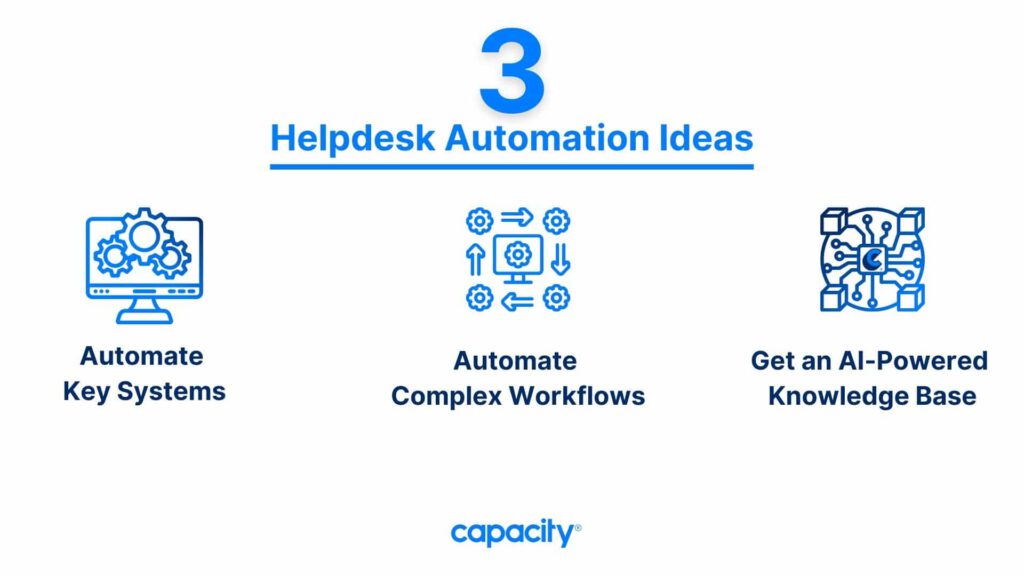
1. Automate Key Systems
When employees can’t find the information they need when they need it, it can cripple a business. Employees spend over 3.6 hours each day searching for data in multiple systems to find a straightforward answer.
All businesses have critical systems in their tech stack that are essential. CRMs and custom databases might be used to find important information, such as company records or customer details. However, with many of these same systems, large amounts of data and knowledge are not easily accessible.
It’s scattered all over the org – in documents, systems, and the minds of employees.
With helpdesk automation, this information can be pulled automatically from different sources and put in one place. This can turn a 5-hour long report into a 5-minute project.

2. Get an AI-Powered Knowledge Base
Another first step toward helpdesk automation is to create a centralized knowledge base where information is organized and updated for both the customer and employee. Most knowledge bases are meant to be entirely self-service, which means they aren’t used to their full capacity.
The upside to using an AI-powered knowledge base when paired with helpdesk automation are as follows:
• Guides customers to find their own answers
• Gives instant access to common FAQs at all times
• Reduces the number of support tickets across the org
• Increases the time support teams can focus on strategic work
One of the most common helpdesk problems is a lack of communication between a customer support team and other departments. This can confuse and lead to frustration between tiered IT support teams. The solution is to ensure departments communicate effectively, so everyone is on the same page. Put simply, a knowledge base that AI and automation power can fulfill both employee and client requests for info much more quickly than a standard knowledge base.
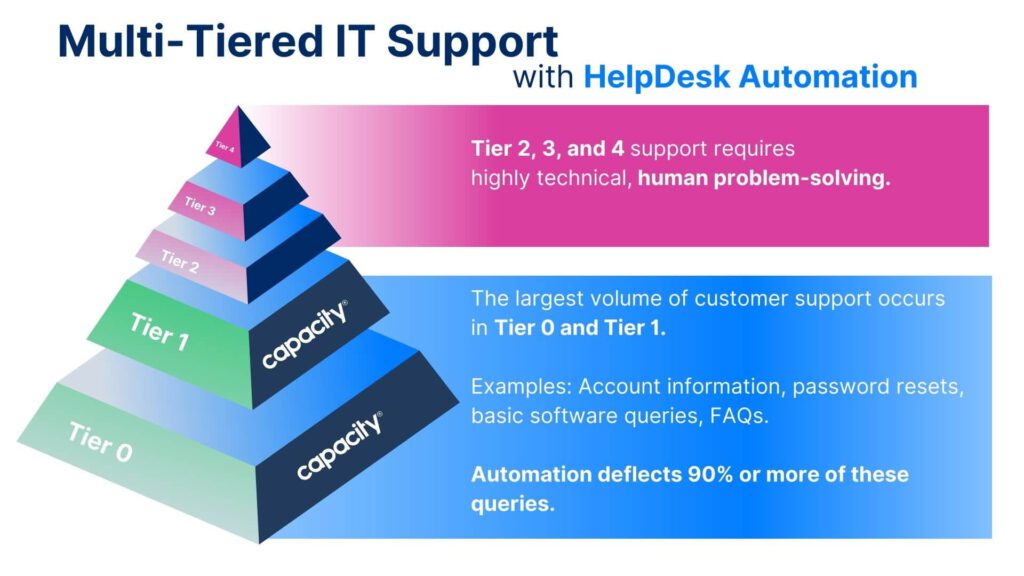
Automate Complex Workflows
In every business, some tasks belong to larger workflows that are mission-critical to organizations. These same workflows are dependent upon multiple team members who have the expertise to complete a task, so the work continues to flow through the process.
Humans are human, which means a sizeable manual workflow can fall apart if just one human is on vacation, takes another job, or retires. That leaves the rest of the team, and the organization in a bind. That’s where automating workflows enters the chat.
Workflow automation can relieve support teams by automating processes as simple as sending confirmation emails to approve PTO or giant, complex workflows in big businesses in highly technical industries (SaaS, insurance, mortgage, etc.) that require lots of human expertise.
Here’s an example: In an automated workflow, Colette gets a notification alerting her to upload a document. When that action is completed, the next task in line is automatically assigned to her coworker Greg, who also receives a notification that he’ll need to review the document. This process continues until the workflow is completed.
There are often many steps in workflows. There are also multiple workflows. Automating them, whether small or large, removes the anxiety of keeping track of tasks that need to be completed. In this case, workflow automation becomes a third-party project manager.
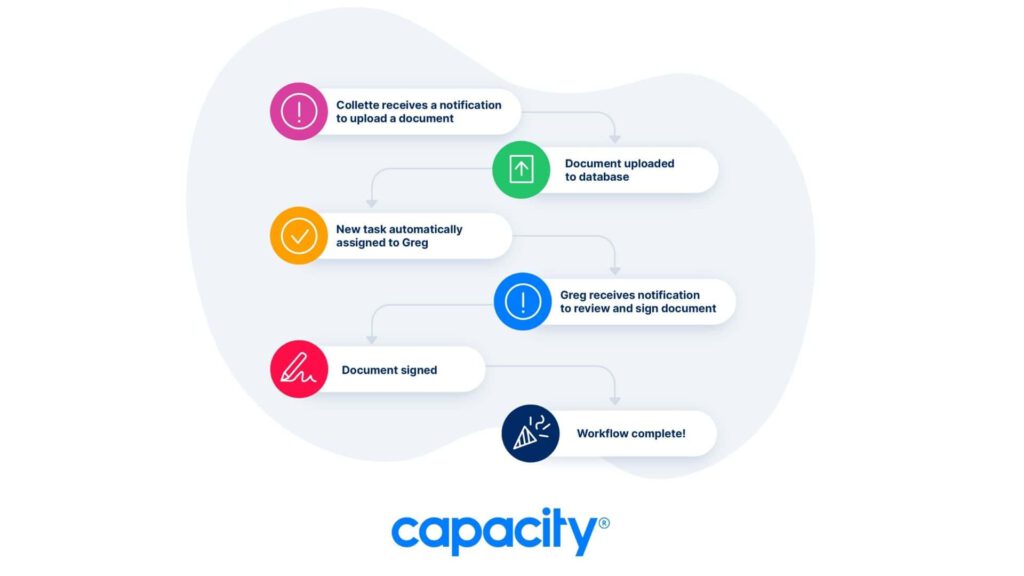
4 Steps to automate your service desk
Service desk automation takes outdated helpdesks to the next level. Automated service desks allow support teams to eliminate 90% or more of repetitive tasks and questions, whether intercepting emails to provide personalized responses before they hit an inbox or investing in a great chatbot.
1. Get an Email Interceptor
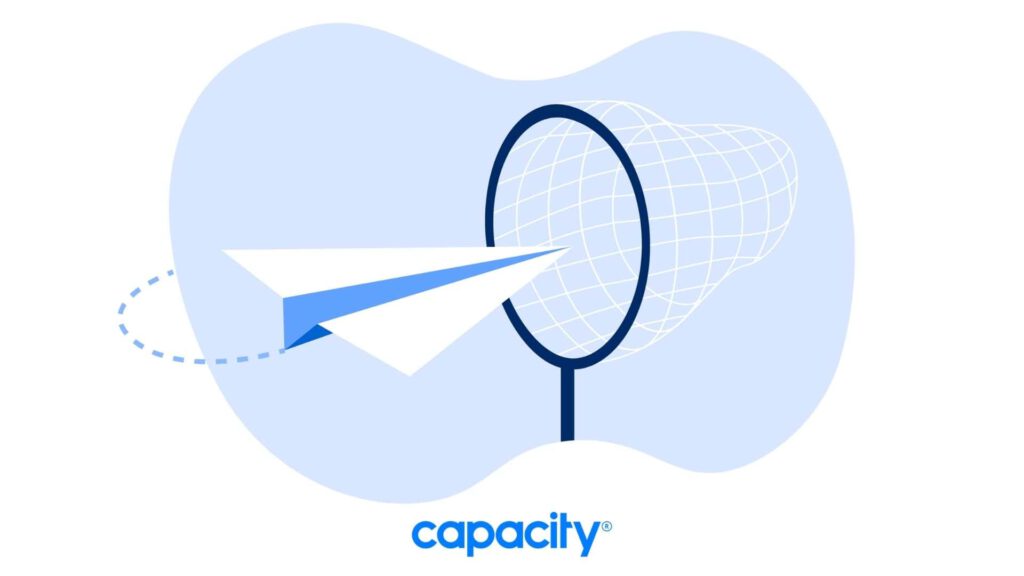
Email interceptor is all about deflection. Support teams across the entire organization get hundreds of emails in their inbox daily. You’ve heard the phrase “the meeting could have been an email,” but who needs another email? Reducing emails keep employees focused on high-value work and reduces task-switching.
Instead of a support team member answering the same questions again and again, email interceptor steps in to respond automatically via email to give helpful information AND close out tickets. With an email interceptor powered by AI, customers and employees get instant help 24/7/365.

Get Started with AI
Capacity’s customized AI Assessments can help:
- Identify opportunities for using AI
- Prioritize use cases that fit your goals
- Build an action plan for implementation
Your email interceptor should be able to securely scan the question posed and search through systems and knowledge bases to find correct, accurate answers. The customer gets an immediate response, and the support agent gets more time back, thanks to the deflected ticket. The ticket gets escalated to the correct email inbox if it is more complex.
2. Invest in a good AI Chatbot (but make it 2024)
Chatbot technology needs to evolve. And it has, in some businesses. Standard chatbots built into old helpdesk systems that live on websites or in-app are no longer enough to keep up with growing volume.
Chatbots that use practical and generative AI can elevate your helpdesk or service desk. Think of an AI chatbot as an extension of your team. The chatbot deflects Tier 0 and Tier 1 questions, so your human support team can focus on deeper technical support issues. Thanks to conversational AI technology, the chatbot communicates just like a human team member. Since the bot constantly learns, it stays up-to-date on the latest and greatest information.
Additionally, AI chatbot technology can function internally inside the most-used apps in your tech stack, such as Slack or Microsoft Teams. This means the bot can help both internal teams and external customers have access to vital information.

3. Automate Customer Satisfaction (CSAT) -or- Net Promoter Score (NPS) Surveys
Continuous improvement and growth are vital to every company’s customer satisfaction strategy. Service desk automation helps survey your employees and customers to identify pain points and areas of enhancement. Any business that expects to stay in business should be tracking customer reactions and needs. With CSAT and NPS surveys, companies can automatically and proactively get customer feedback before it turns into a negative review. They also help measure customer loyalty and see where and what your business should be investing in.
Service desk automation systems can automatically push surveys to customers and internal teams. Once users submit their survey information, automation technology sends the data directly to your key systems. Then, support teams can analyze customer data to help make better business decisions: no Google sheets, no excel, just data.
4. Decide on your implementation plan
Before starting your service desk automation process, a good first step we’ve seen from our customers is to decide what your business needs to automate. What are the significant problems to solve in your org?
• Seeing overwhelmed support staff
• Piles of backlogged or delayed support tickets
• Wasting time trying to find data and documents
• Answering the same questions over and over again
You know the issues are critical to your organization; pick just one pain point and decide how service desk automation can solve it. After you identify these, you can effectively start on an implementation plan even before you start searching for software, which includes getting buy-in from leaders and support teams. Once you begin automating your service desk, the sky is the limit.
Automate your helpdesk with Capacity
Finding a helpdesk automation solution can be a challenge. If your business is ready to scale, if you’re seeing your support team stretched, if you have too many emails and chats hitting all areas of your business, Capacity’s platform is right for you.
Capacity is not your average ticketing system or helpdesk tool.
Save Time & Money
Capacity helps businesses deflect ~92% of inbound lead inquiries, saving employees over 200 hours per week.
Place Capacity natively on your website, or integrate with your most used applications such as Slack, Microsoft Teams, Jira, Salesforce, Canvas, and more. We connect securely with all of your systems.
Whether you need an AI-powered chatbot, an email interceptor, a better knowledge base, or a ticket destroyer, Capacity meets you where you are.
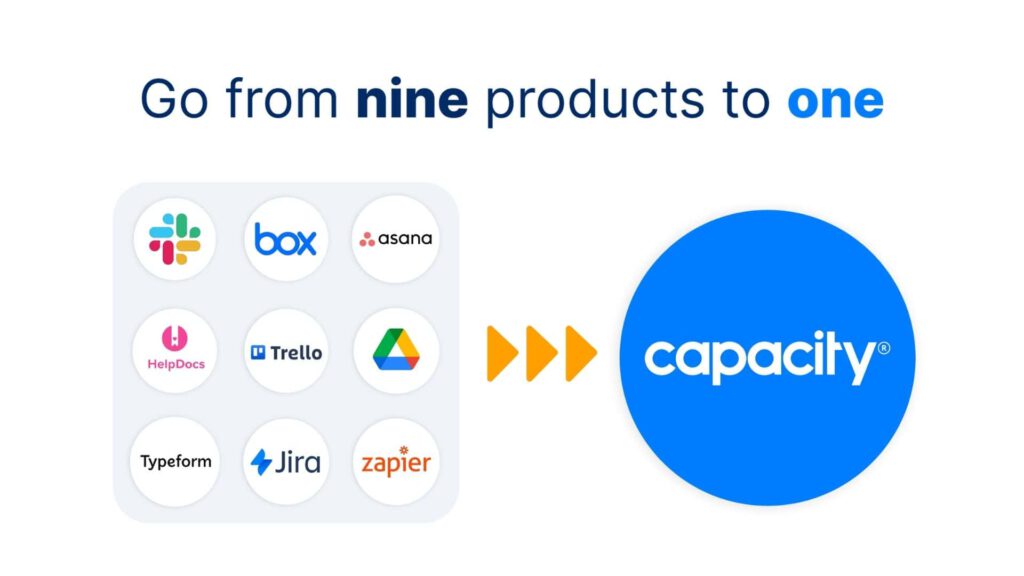
Scale Your Business
Nearly half of all businesses spend $100 or more per hour on customer support. Regarding automating support, Capacity helps companies save time and money. As customer expectations rise, businesses will need to evolve to keep up with demand.
Learn how to get started with AI with a customized AI Assessment, tailored to your org’s unique goals and needs.

Get Started with AI
Capacity’s customized AI Assessments can help:
- Identify opportunities for using AI
- Prioritize use cases that fit your goals
- Build an action plan for implementation


